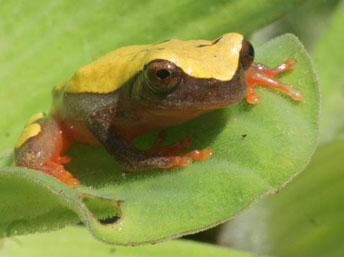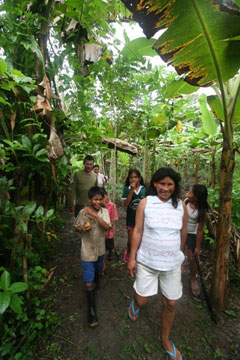Special to mongabay.com: Wilderness Classroom: Expedition 2006 The following is an update from The Wilderness Classroom’s expedition to the Peruvian rainforest. You can follow their adventures at wildernessclassroom.com |
Sloths are not lazy, they are just slow
The Wilderness Classroom Organization
May 2, 2006
Update 14: Ice, cold Coca Cola! – Dave
I really enjoy our simple diet, but the thought of drinking something
ice cold after weeks in the hot, wet rainforest was more than I could
resist. After several weeks of eating rice, beans, fish, and bananas,
we took a motor boat into the town of Bretana and treated ourselves to
candy and ice cold Coca Cola! Bretana only has electricity from 7 PM until
10 PM, but they use their limited electricity to keep large coolers filled
with cold drinks.
During the day the sodas are not very cold, because there is no power
to run the coolers. However, if you go to the store in the evening, after
the electricity has been on for a few hours, you can buy ice cold drinks,
which are a huge treat this close to the equator.
We also stocked up on cans of tuna fish, tomato sauce, animal crackers,
and chicken seasoning. These special treats make our otherwise very plain
food taste much better after a long day of exploring the flooded forest.
Yesterday we took a motorboat from the mouth of the Pacaya River to the
town of Manco Capac. Manco Capac is smaller than Bretana, and it does
not have power, refrigeration, or cold Coca Cola, but it is a very interesting
community full of very nice families.
 Dave prepares to send an update using a laptop computer and our satellite phone |
The flooded waters are no longer covering the town of Manco Capac, and
everyone is celebrating by playing volley ball, and soccer. Warren and
Patrick joined one of the many soccer games. They worked up a good sweat
with about fifteen 8- to 10-year old boys.
This morning we carried all of our gear, and dragged our canoes across
a large soccer field. The flooded forest on the far side of the field
drains into the Yanayacu River. As the last pieces of gear were being
loaded into the canoes, I ran back to town for one last treat. I had spotted
a pile of fresh eggs in a store on the edge of town. I quickly purchased
20 eggs for 5 soles, and trotted back to our canoes.
With our food bags buldging with our newly purchased food, we slowly
wove our way though the flooded forest towards the main river channel
of the Yanayacu. For four hours we inched through the forest, using trails
that you follow on foot for half of the year, and paddle canoes down for
the other six months.
I enjoy the sights, sounds, people, and creature comforts that we find
in towns like Bretana and Manco Capac. But it feels good to be back in
the rainforest. There is nothing I enjoy more than gliding silently through
the flooded forest.
 Frogs are everywhere in the flooded forest. We found this one on a floating plant in the middle of a large lake. |
Update 14: Sloths are not lazy, they are just slow – Patrick
Directly across the river from where I write this, a three-toed sloth is napping in the highest branches of a Cecropia tree. It is curled up in a tight ball- although it is hard to tell, I think it is upside-down as well. Although it is closely related to the armadillo and anteater, there is nothing else like the sloth. They look something like “strange monkey,” but their movement and metabolism, or process of breaking down food, is very different than a monkey’s.
Why are sloths slow? First of all, slow movements helps the sloth escape notice from predators like the jaguar, harpy eagle and anaconda. They look like a “lump on a log,” so predators think it is just another termite or ant nest. Secondly, a sloth’s diet is leaves, leaves, and more leaves. Leaves are difficult to digest, so a diet of pure leaves provides little nutrition. That means they must eat a lot of them to stay alive. The sloth has a very low metabolic rate and low body temperature. In fact, at night, sloths save energy by lowering their body temperature as much as 20 degrees to match that of the environment. That way they don’t have to burn energy trying to stay warm or cool. We’ve noticed most sloths stay way up in the trees where they can bask in the sun and stay away from predators.
Like most plants and animals in the rainforest, sloths have developed relationships with other organisms to promote life- called mutualism or symbiosis. The surface of the sloth’s hair has many groves and pits in which algae and fungus grow to turn the sloth greenish. The green color helps the sloth be better camouflaged. Fungi are basically mushrooms; algae are microscopic organisms that- like plants- use sunlight as food. Not only do sloths support plants on their bodies, they support insects as well. Several beetle and moth species spend a part of their life cycle living on sloths. The “sloth moth” lives in the sloth’s hair and lays its eggs in the sloth’s droppings.
Now that is one interesting animal. Guess what? It even swims in the water too!
Fish soup for breakfast, anyone? – Anna
How would you like to wake up to a piping hot bowl of fish soup? How about a side of fried bananas, and some rice? And get used to eating eyeballs, cheeks, and tails, because in the rainforest, we eat the entire fish from head to tail. Welcome to life in the rainforest!
 Carmen, who is pregnant with her fifth child, led us on a tour of her beautiful garden. |
In the town of Bretana, we met Carmen and her four children. They gave us a tour of their huge garden and told us about the foods they eat. Common staples (foods that people eat every day) include rice, bananas, and yuca. Yuca is a wild root, much like a potato, and it grows everywhere! The local people eat yuca like you would eat a potato: boiled, fried, or mashed. Banana plants, although not native to Peru, can be found in most people’s gardens. There are many different varieties; some are sweet and some are more starchy. They grow fast, and within a few months, a huge bunch with over 50 bananas can be harvested. People eat the bananas fried, boiled, raw, steamed, and in soups. Yellow or green, skinny or fat, sweet or not, bananas are served with nearly every meal.
Carmen also introduced us to her chickens and ducks. Most families have these birds roaming around their yards. The animals can be used for their eggs, as well as for meat. Most people don’t eat chicken and duck every day, but they do eat several kinds of fresh fish from the river almost every day, including piranha and catfish. Like the bananas, they eat their fish boiled, fried, and in soup. Carmen’s family hunts other meats as well including: monkey, armadillo, tapir, paca (a large rodent that is said to be delicious), and peccarry (wild hog).
The family garden was full of all kinds of fruits and vegetables. The kids took us around their yard and showed us bananas, lemons, limes, avocados, cacao, mangos, coconut, guava, yuca, potatoes, coffee, papaya, and several other exotic fruits that I had never heard of. Carmen’s family was so kind that they let us sample nearly everything in their garden, except of course for the chickens and ducks, since they still had a few months of plumping up before being ready to eat.
People that live in the rainforest can not rely on grocery stores to keep them fed. They must grow, harvest, and hunt their food. I wonder what foods we would eat if we had to rely on gardening and hunting, like the people do in the rainforest. How much of the food that you eat every day can be grown in your backyard? I would love to grow avocados and pineapples, but I probably wouldn’t be growing any Oreos, pretzel rods, or Lunchables in my garden!
How about some quinoa with a side of rocks? – Anna
When we were shopping for supplies in Iquitos, we were so excited that we found a very nutritious whole grain food called quinoa. Quinoa is a tasty grain that is full of protein. It is common in the highlands, and is eaten much like rice.
Since quinoa is tasty, healthy, and goes with anything, we bought a lot of it for our trip. The first night that we ate the quinoa we noticed that it was full of rocks and sand. Apparently, when the people in the highlands of Peru harvest the quinoa, they dry it on the dirty, sandy, and rocky ground. So the next time we prepared the quinoa, Ruben and I spent a long time searching through huge mounds of grain, removing as many small rocks as we could find. Then, we washed the quinoa and sifted it through my mosquito head-net to remove extra sand. We were sure that our problems were solved, but unfortunately, that night we were once again crunching and grinding our teeth against rocks and sand. It made for an unenjoyable eating experience.
We have a lot of quinoa left, and we are going to have to either eat it, throw it away, or give it away. If we get rid of it, we will need to buy some rice or potatoes in a town to make up for our food loss. I don’t know if giving it as a gift is a good idea; it might not make people very happy when they realize that we gave them rocky quinoa in return for their kindness.
Because it is quite an unpleasant eating experience, none of us want to have to eat the quinoa again. But we did buy it, and we bought a lot of it. Plus, it provides us with essential protein, which we don’t get in a lot of other foods. We hate to be wasteful, but…
Track the adventurers at wildernessclassroom.com